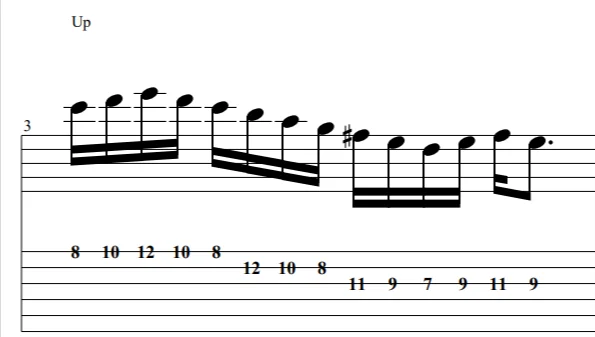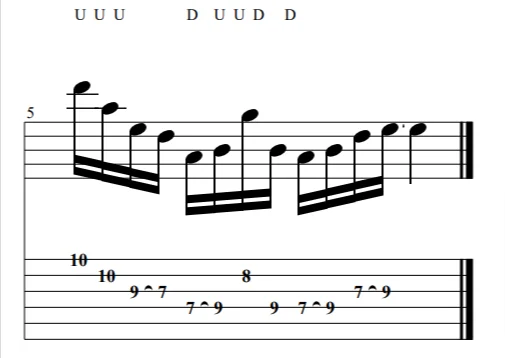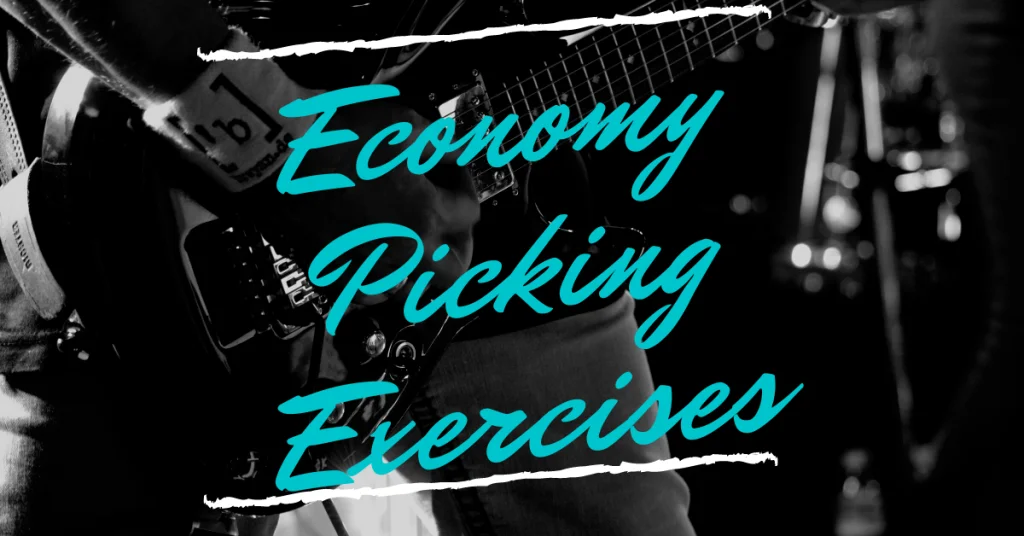Table of Contents
Economy picking is an essential guitar technique. It dramatically improves picking speed and picking accuracy. Plus, it decreases the amount of energy used in both the picking and fretting hand.
Learning these 5 best economy picking exercises for guitar is one of the best ways to get started with economy picking.
What Is Economy Picking?
Economy picking is simply put: Following the economy of motion with your guitar pick.
For example: if you’re moving from the A string to the D string, you could either pick:
Down on A and Up on D (Alternate Picking)
Or Down on A and Down again on D (Economy Picking)
It was brought to light by Frank Gambale, a respected jazz fusion guitar player known for his playing with Chick Corea.
You can read about Frank Gambale on his website: https://www.frankgambale.com/
Economy Picking Exercises Tab/PDF
All of these licks come from the E Natural Minor (Aeolian) and E Minor Pentatonic Scales.
Economy Picking Exercise 1: E Minor 7 Arpeggio

For this first exercise you’ll be working with a 2-1-2 arpeggio pattern. (2 notes on a string, 1 note on a string, then repeat)
Your picking hand will move like this:
( D=Down H=Hammer-on U=Up PO=Pull-Off) (Groups of 2 notes are Bolded)
D-H D D-U D D-U-PO U U-D U U-D
You can use this right hand economy picking pattern to play any arpeggio that moves in a 2-1-2 motion.
Economy Picking Exercise 2

This is the E Minor Scale played 3-Note-Per-String at the 7th position.
You simply want to move D-U-D on each string.
You can also practice this exercise backwards by starting with an upstroke on the high E string, and economy picking upwards by moving U-D-U.
Economy Picking Exercise 3

You’ll start and end on an upstroke with each string in this exercise. This will help you get used to alternate picking odd groups of notes on single strings before transitioning to adjacent strings using economy picking.
Economy Picking Exercise 4

After you’ve picked the first note with a downstroke (and done the hammer-on), you’ll move from the 7th fret D string to the 10th fret A string with a 2 upstrokes (which creates a single upward motion), and you’ll play the last 2 hammer-ons with 2 downstrokes (which creates a single downward motion).
This exercise demonstrated a hybrid of alternate picking, hammer-ons, and economy picking.
Remember, technique is just a tool used to execute/play your music. Combine/use whatever techniques are necessary for playing music.
Economy Picking Exercise 5

The first 3 notes in this exercise can are played with 3 upstrokes and a pull-off.
You’ll then move to a downstroke+hammer-on on the D string, then transition to an upstroke for the 8th fret of the B string.
You’ll swipe through the G string (From B-8 to D-9) with this single upstroke, and end the lick with 2 downstrokes (D-H, D-H).
This exercise demonstrates the power of swiping/sweeping through sets of strings with single upstrokes and using legato (hammer-ons) when moving in downward motions.
Is Sweep Picking Economy Picking?
As a general rule sweep picking is economy picking. It’s a sub-form of economy picking where you are playing 1 note on each string as you move up or down.
Check out my lesson on sweep picking here:
Economy Picking Exercises Conclusion
These economy picking exercises not only teach you the basic definition of economy picking, but they show you the core principle behind economy picking: Follow the economy of motion, and do what is necessary with the picking and fretting hands to effectively execute whatever it is you’re playing.
With that being said, let me know your favorite exercise in the comments below!



